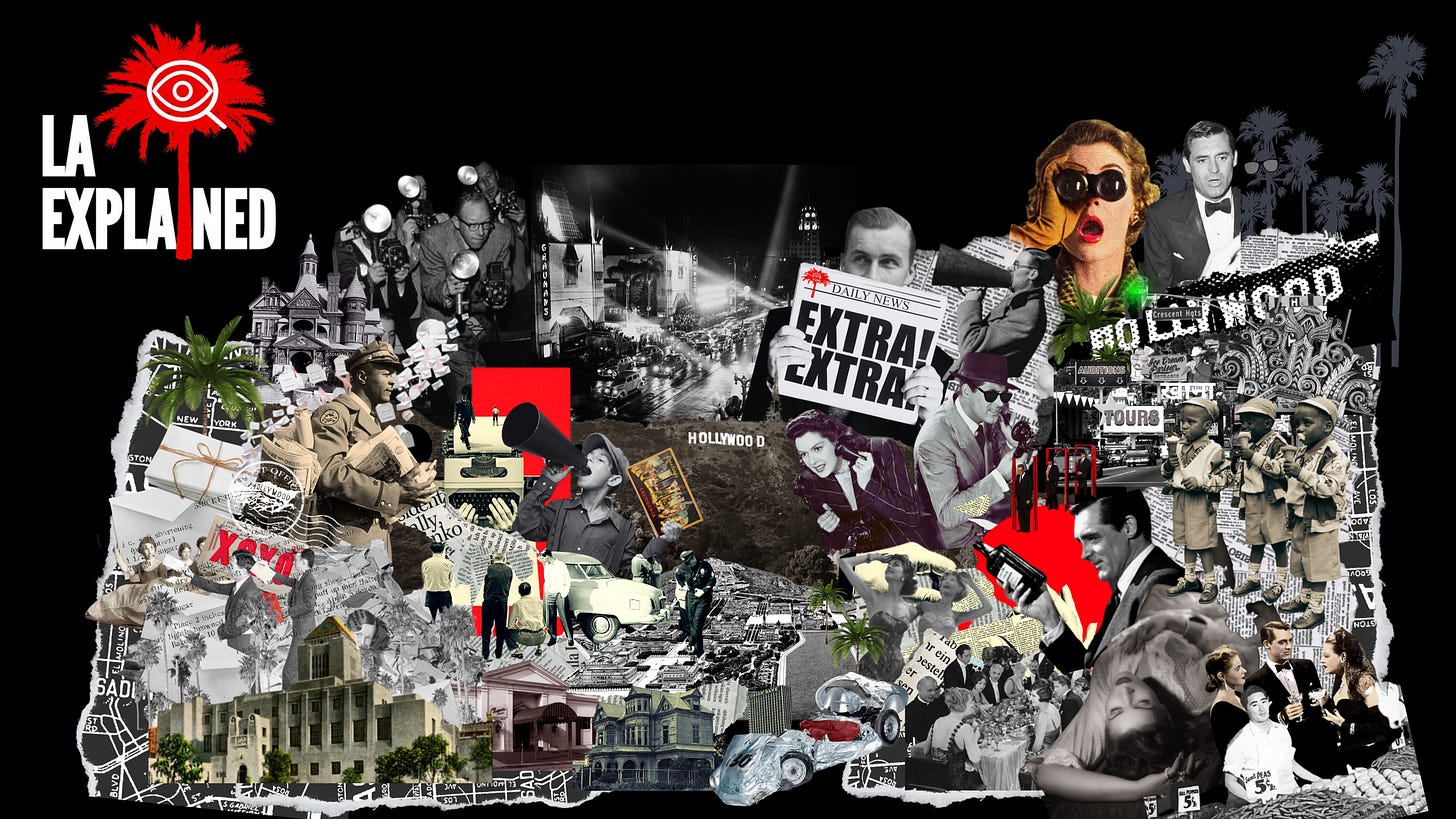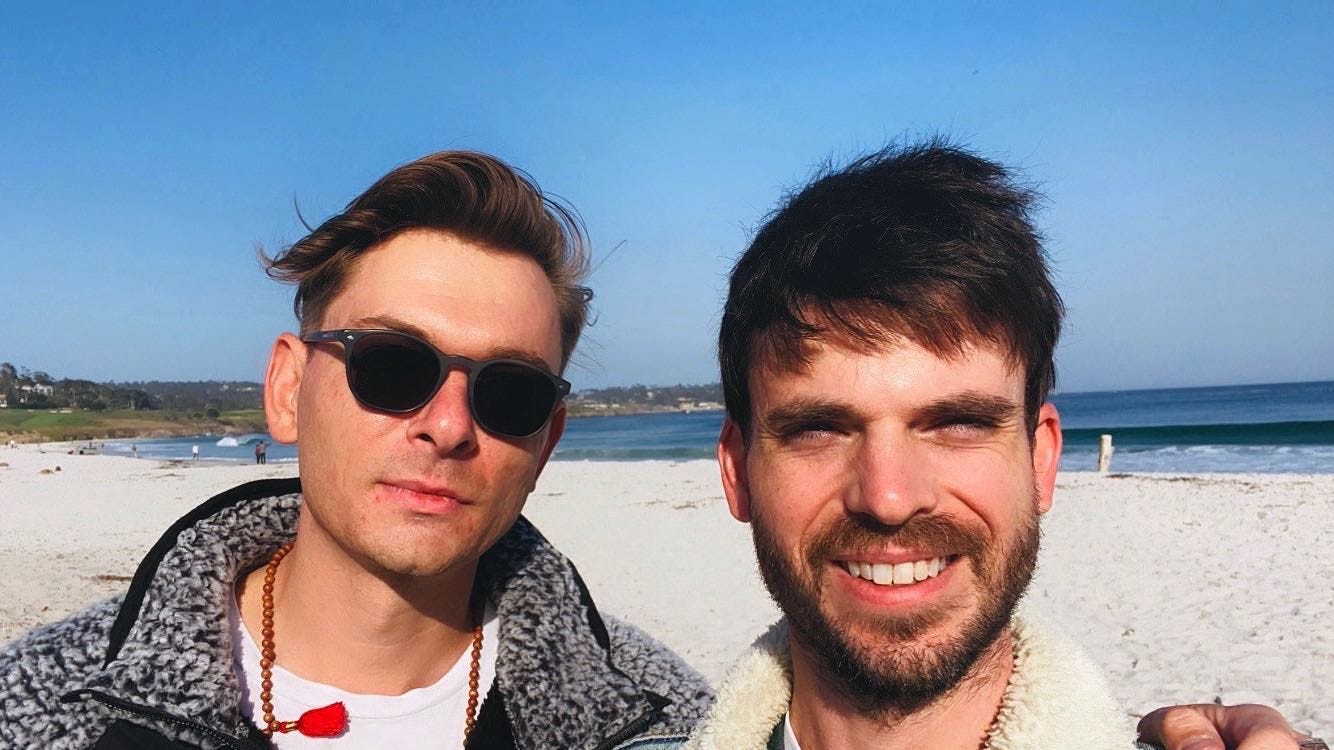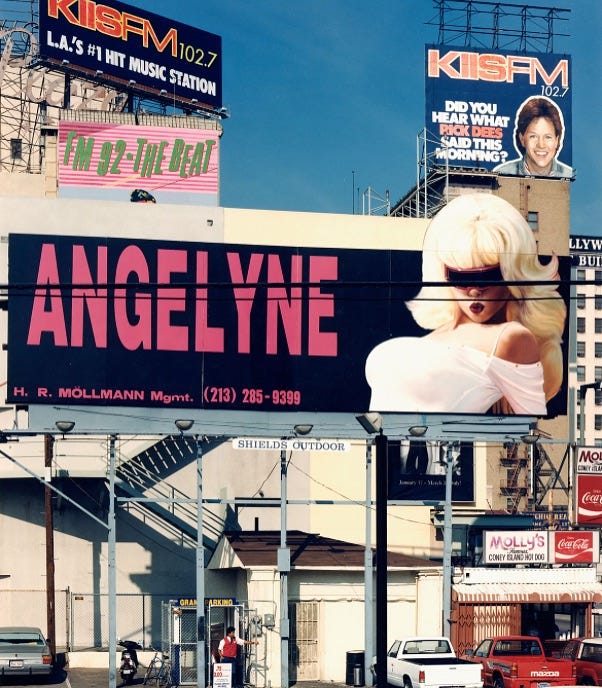LA Explained: Find the magic and share it with people
A conversation with co-founders Charles Ryan and Thom Vest
Welcome to Human Pursuits, the column that features need-to-know names and stories in media and other creative spaces. Today, a conversation with LA Explained co-founders, Charles Ryan and Thom Vest.
CORRECTION: In Wednesday’s OML, I wrote the wrong date for Libero’s pop-up event. It’s happening the weekend of June 20-22 from 7 A.M. to 7 P.M. at Organic Press Cafe on Annette Street in Toronto. My bad!
Sometimes, when I miss the SoCal sunshine and the Santa Ana Winds and the light refracting off the water in the Hollywood Roosevelt’s Hockney-designed pool, I scroll over to LA Explained and let my mind wander through the annals of Angeleno history.
The Instagram page, started by Charles Ryan and Thom Vest during the pandemic, is an ever-expanding archive, offering a hyperlocal perspective on the city and the angels who call it home. Recent carousels have spotlighted the likes of Brian Wilson (RIP), Top’s Pastrami & Burgers, the Westside Pavilion, and Gidget, the Taco Bell chihuahua, to name a few.
But while the brand is rooted in respect for the city’s history, here in the present, LA Explained is growing into a bona fide business, with Charles and Thom planning community events (Skyline Cinema Club) and gourmet trolley tours (tickets here).
While I’ve wanted to interview them for years, we happened to connect the same week President Donald Trump and Defense Secretary Pete Hegseth authorized 700 Marines and more than 2,000 National Guard troops to Los Angeles amid mostly peaceful protests denouncing immigration raids.
And so, we had much to discuss.
Our edited and condensed conversation touched on what they’ve been seeing in the City of Angels this week, lessons learned while running LA Explained, their favourite tourist attractions, the power of black and white photographs, why it’s important to share what you love, and more.
ES: We’re speaking at yet another inflection point in L.A.’s history, given the ICE raids and ensuing protests. A curfew was issued Tuesday night. It’s now Wednesday morning. What’s the vibe like on your end?
TV: I think a lot of what we’re seeing in the media right now is probably more heightened than what the reality is. We’re right in Hollywood, and if we didn't know what was going on, we would have no idea what’s happening downtown. Now, whether that’s by design or not is a bigger question.
What’s so cool about what we’ve created with LA Explained is that it’s a platform where people share their own experiences… We don’t see ourselves as experts in anything other than perhaps historical context. But we are here as a safe space for people to share their own experiences. That’s what the brand has always been about. L.A. has always been a very multicultural place. It's always been a good example of the melting pot that America is. There are so many different cultures and neighborhoods, and every neighborhood is so different. It’s a little tense to see different factions getting at each other in our comment section, but overall, what we’ve built leaves people feeling safe to share their own experiences.
CR: Building off what Tom said, one thing that I’ve noticed in the past few days is that, close to us, at one of the entrances to Griffith Park, there normally is a fruit vendor. He hasn’t been there for days, which is probably because of the raids. The news is getting that part right. People are not out on the street like they normally would be. Half an hour ago, I was out doing errands and certain areas, like Santa Monica Boulevard and Western, which is a pretty Latino area and normally very busy, was kind of a ghost town.
I haven’t seen any of the National Guard trucks or ICE… The thing I've noticed is that there are fewer people out on the street.
TV: People are scared.
CR: And I’ve overheard people talking about it. Obviously, this has not been the best year for L.A.–
ES: That’s an understatement. It’s been a hard year for ya’ll.
CR: On top of the overall exhaustion politically in the U.S., I didn't see L.A. being the centre of this whole thing, the administration using it as an experiment to do it in other places. I am currently trying to figure out how I can approach the topic with LA Explained that doesn’t seem contrived.
ES: You mentioned the community that has formed around the brand. Have you noticed any changes in how commenters are feeling after the first half of 2025, with the fires and now this? Is there a desire for more uplifting content, for example?
CR: Yes. We’ve learned the hard way that people want us to stick pretty close to our tag line, which is “A celebration of the City of Angels.” They prefer that over us diving into things that are more divisive.
TV: Like famous murders, or other L.A. stories they don’t want to hear about.
ES: That’s really interesting.
TV: Dodgers Stadium is a no-go. You cannot bring it up.
ES: Can we talk about that? Why is Dodger Stadium controversial?
CR: It’s a difficult subject for Angelenos because it’s really fraught with….
TV: Racism.
CR: Racism. Some of the current context isn’t correct, but it’s all rooted within racism.
Dodger Stadium was built on what used to be a neighborhood in L.A. that was home to mostly Mexican immigrants. For many of them, it was their first home. It wasn’t a nice area, necessarily, but it had a community, it had its own schools, it had its own public services, it had its own little stores and everything. This was from the late 1800s. Dodger Stadium was built in the late fifties, I want to say.
The city of L.A. wanted to turn the area into public housing estates. And so it treated the neighbourhood like a quote-unquote slum clearance. They wanted to wipe it out for development. All the residents were forced from the area, but then the plans fell through. The city elected an anti-communist mayor, and he thought that public housing estates were a communist idea. So when the Dodgers were moving to L.A., and looking for a site to house their stadium, the city thought, “This is the perfect spot.”
So the Dodgers arrived after the fact, but most people don’t really understand the timeline. It wasn’t a plan initiated by the Dodgers. The city did everything beforehand.
ES: You’ve both lived in other places — Thom in NorCal and Charlie in Australia. How has your understanding of L.A. changed since launching this project?
TV: The main thing I always think about is preservation. Australia is a good example of this. Melbourne, where Charlie’s family lives, protects historic buildings. They only tear them down if they absolutely have to. Essentially, if the building is unsafe. I wish that were the case here because you look at neighborhoods like Bunker Hill, which was a nice part of Los Angeles when it was first built, but they wanted to tear it down to do a new business district.
I’ve had multiple instances where a younger person will ask, “Why is the image black and white? It’s from the 90s.” And I have to say, “Well, this was printed in the newspaper.”
Especially in the 90s, they were bulldozing anything they possibly could. They didn’t care how historic, how beautiful, how impossible it would be to ever recreate anything like that. It didn’t matter because they wanted to put in a parking lot or some hideous dingbat apartment building. L.A. was one of the most beautiful places in the world. You had the foremost authorities in set design, the people who created the movies, building these insane, beautiful palaces. The entire city looked like a film set. Now you look around, and… We always joke that when it’s not sunny in L.A., it’s the most hideous city in the world.
I think it’s important, for the younger generation especially, to realize that they’re walking by buildings and locations and things that changed the course of history for Los Angeles, but also the world at large. If we continue the way things have gone, we’re going to turn around one day and face a city we don’t recognize.
People visit and they leave thinking “L.A. sucks!” No, you're just getting a crappy tourist version of it. They go on stupid tours, and they’re looking at hideous parking lots with LED lighting. They painted over the history that was there. Like, Marilyn Monroe’s home was almost bulldozed. The only home she ever owned, that she spent the most time in, was about to get bulldozed because somebody wanted to build a McMansion…
ES: Charlie, when it comes to image selection, you’ve said that color photos always tend to do well. Are there any specific characters or people from L.A. history that tend to resonate with people?
CR: Posting regular Angelenos tends to be pretty popular. For context, we don’t post anything after the year 2000. That’s the cutoff for me, though, as time goes on, I guess I will have to push the date back a bit.
In terms of color versus black and white photography, the older generation is more comfortable recognizing a black and white image. It’s to the point that I’ve had multiple instances where a younger person will ask, “Why is the image black and white? It’s from the 90s.” And I have to say, “Well, this was printed in the newspaper.”
ES: No way. Laughs.
TV: There are some people like Angelyne, the Billboard Queen, who are also a good example. We just posted about her, and she’s a local celebrity. Unless you’re in L.A., you don’t know who she is. People love that.
CR: There’s also Harry Perry, the roller-skating guitar player on the Venice boardwalk.
TV: He’s a real character.
CR: Everybody knows them. There’s a connection, or some kind of local camaraderie. A feeling of “Oh, I know that person.”
ES: It's funny, though, because while that’s true, I follow the page and I live in Vancouver. There’s an insider knowledge to it, but I think it has broad appeal.
CR: Because I didn’t grow up here in some ways, I understand what L.A. looks like from the outside, and what outsiders think it is. At the same time, I have so many family and friends who are not from here, and they will come to stay with us and want to do certain things.
Like, okay, I will take you to Hollywood Boulevard this one time…
TV: If you must.
CR: We’ll look at the stars there, but honestly, it’s awful. I’m sorry. It’s part of Los Angeles, but it’s not the Los Angeles that leaves you thinking you’ve just visited a great city.
You have to know where to find the magic, and then share it with people…
ES: Where do you like to take people instead?
CR: If we’re on Hollywood Boulevard, we’ll include other things in the experience. Hop into the Hollywood Roosevelt hotel, which has been around for almost a hundred years.
ES: I got engaged at the Roosevelt, so I love that.
TV: It’s awesome. And there's a lot of history with the Hollywood Walk of Fame that people don’t know about… There’s a department that deals specifically with the history of the Hollywood Walk of Fame, which is quite interesting. You see the history and the progression of how it came to be. There’s a museum called the Hollywood Heritage Museum. It’s full of artifacts that tourists would lose their minds over. People don’t even know it's there. They’re too busy looking at the sidewalk.
ES: If only there were some sort of tour — potentially on a trolley tour — that could show people a different side of the city.
TV: Right? That’s the point. We wanted to share our version of L.A. with people. And what's funny is that about 80% of people who take our tours, or come to any of our events, are locals. We thought we were catering to tourists originally, and we’re not. It’s been cool.
We started the tour because we were doing a pop-up museum. It was all crowdsourced artifacts, stuff that belongs in a real museum… We needed more time to finish the museum, because we wanted to do it right, and so we thought, “Oh, it’d be fun to rent a Starline Tour bus and do a one weekend thing.” We planned it, but I didn't realize that I hadn’t provided a ticket sale cut-off.
The next Monday, we had gone viral on TikTok… We were booked for 26 weeks in a row… Now, a lot of other companies are knocking us off, using our name. Every now and then, I shudder because I’ll get an email from someone complaining about their experience. I have to explain, “That was not our tour, babe. I hate to inform you.”
But yeah, this is the vision of Hollywood that we have. You have to know where to find the magic, and then share it with people… We've been doing pop-ups and temporary things for the last five years. Now we’re looking at some pretty iconic historic locations that have been sitting vacant for a really long time and asking, “How can we bring new energy into this place, and breathe new life into it?” We’ve got rooftop movie screenings that we're doing now at the historic Montalbán theater in Hollywood, which has been awesome….
It’s exciting to see Angelenos appreciate what we're doing. For a long time, we felt like we were just kind of screaming into the toilet. It was something to pass the time during COVID. But as restrictions started lifting, LA Explained has remained our focus because it’s what people want.
Charles Ryan and Thom Vest are co-founders of LA Explained. They live in Los Angeles.








